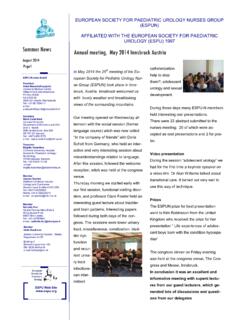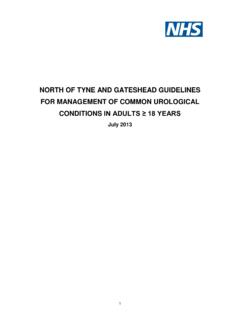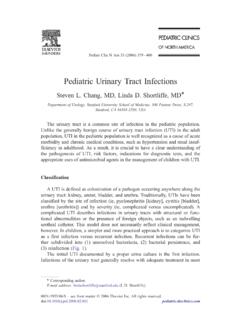Transcription of Bristol Royal Hospital for Children Guidelines for General ...
1 Bristol Royal Hospital for Children Guidelines for General paediatric surgery of Childhood in the Regional Centre/DGH Eleri Cusick Note: These are General Guidelines which have been requested by General surgeons in the South and West with an interest in paediatric surgery / paediatricians. They are not intended to be either prescriptive or exhaustive. Elective Patients for referral to Regional paediatric Surgical Centre (BCH) All neonates infants less than 44 weeks gestational age All infants/ Children requiring complex General surgical operations All oncological procedures All specialist urology Consider referral in: All Children with complex medical problems requiring even simple surgical procedures Diabetes, Congenital Heart Disease, Cerebral palsy etc.
2 All Children likely to need perioperative PICU Elective Patients for surgery in local DGH Inguinal Herniotomy: Incarceration is common in first 6 months of life (greater than 60%). In Children under 1 year of age we would try and repair these as soon as conveniently possible, usually within 2 weeks of out-patient referral. The younger the child the more urgent the operation. surgery should never be delayed because the child is too small or too young. Our only exception to this rule is a preterm infant who is an inpatient in SCBU.
3 We would aim to repair all SCBU hernias before the infant is discharged some notice is helpful to facilitate beds/list time. Children older than one year may safely be placed on the waiting list. Always warn parents of risks of strangulation and need for urgent reduction. Incarcerated = irreducible hernias should be reduced by gentle pressure. There is no place for Gallows traction. A second attempt after 1 hour following analgesia and being left quiet is acceptable. If you fail to reduce the hernia transfer to immediately to the tertiary centre.
4 Orchidopexy: We would recommend that an undescended testis is brought down into the groin in the second year of life or as soon as identified in an older child. In the case of an impalpable testis the investigation of choice is diagnostic laparoscopy (not ultrasound) and they should be referred to the tertiary centre. Epigastric Hernia: We do not routinely repair these unless shown to be symptomatic point tenderness, or major cosmetic concern (child not parent) Umbilical Hernia:. We do not usually repair these until pre-school age and only then if parent/child keen for surgery .
5 Incarceration is extremely rare. Circumcision: Remember only 1-2% of boys need circumcision. Excluding religious circumcision 5% boys are circumcised in this country half of all circumcisions undertaken on medical ground are unnecessary. The following are NOT of themselves indications for circumcision: o Non-retractility in a young boy with a healthy pliable foreskin o Ballooning on micturition o Occasional episodes of balanitis Balanitis Xerotica Obliterans (BXO) is a definite medical indication for circumcision. Further guidance on circumcision will be forthcoming.
6 Lumps and bumps: pre-auricular skin tag. External Angular Dermoid should be excised electively as they continue to grow slowly and can erode through the skull with a dumbbell component intracranially. Emergency patients for referral to Regional paediatric Surgical Centre All neonates infants less than 44 weeks gestational age All infants/ Children requiring complex General surgical operations All oncological procedures All specialist urology Consider referral in: All Children with complex medical problems requiring even simple surgical procedures diabetics, congenital heart disease, severe cerebral palsy etc All Children likely to need perioperative PICU If there is any doubt please phone and discuss with paediatric surgeons.
7 We will not suggest immediate transfer in all cases. In many cases we will be happy to hold a watching brief and accept the patient if the situation changes. If we are unable to accept the patient (bed crises are always with us) we will do our best to direct you elsewhere/ manage long distance as appropriate. Remember if you can see and examine the infant you are hugely advantaged and the ultimate call to transfer (elsewhere) or not must be yours. Consultant to Consultant referrals are infinitely better than registrar to registrar (or heaven forbid SHO to SHO) referrals.
8 Multiple Trauma: Only in the rare case of immediate exsanguination should such patients be operated on outside a regional centre. The majority (>97%) of Children with blunt abdominal trauma and solid organ injury can be managed expectantly in the presence of immediately available specialist input. The Children should be in a PICU. Initial management of a few critical conditions Bilious Vomiting: This must always be considered a surgical emergency when occurring in a previously well infant or child. Bilious vomiting, especially in a neonate/infant, must be considered to be midgut volvulus secondary to malrotation until excluded by an upper GI contrast study, even in the middle of the night!
9 It only takes 6 hours for ischaemia to lead to necrosis. A plain abdominal XR cannot exclude this condition. The diagnosis is made on the basis of a contrast meal correctly interpreted by a skilled radiologist. Very premature babies with a feeding NG tube may have bile tinged aspirates particularly in association with NEC. Where another diagnosis has been made then contrast meal is rarely indicated/practical. If in doubt discuss with the paediatric Surgeons. Obviously there are many other causes of bilious vomiting but these are largely surgical reflecting intestinal obstruction from whatever cause.
10 Acute paediatric GI bleed: These Guidelines refer to a child with an acute GI bleed usually evidenced by frank haematemesis and/or melaena. A child with a large brisk rectal bleed may also be included. They are not intended to apply to: 1. Children with NG tubes who have a trace of blood or coffee grounds in the NG aspirate 2. Children with known reflux who have a trace of blood or coffee grounds in vomitus 3. Children who pass a little fresh blood PR (probable anal fissure) 4. Children with blood streaked diarrhoea A. History is of paramount importance.









